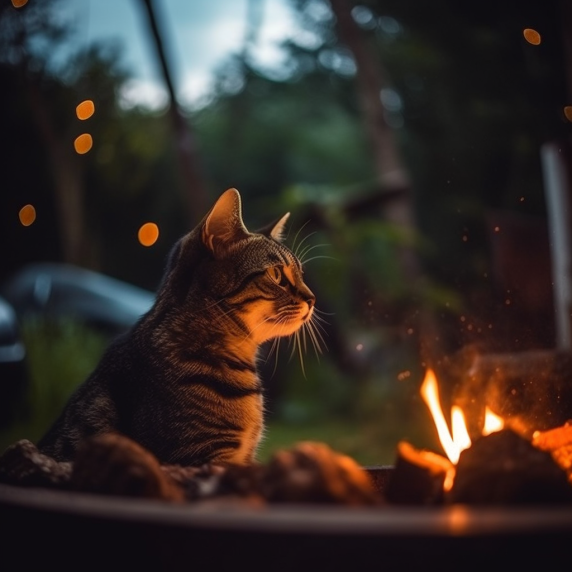Can Cats See Fire? A Maine Coon's Pawspective on Feline Vision

"Can feline eyes truly perceive fire? Join me on a delightful adventure as we unravel the enigma of our extraordinary vision." - Miles the Maine Coon
Introduction
Meow there, curious humans! I'm Miles, a wise and adventurous 5-year-old Maine Coon cat with a fluffy mane that makes me look like a tiny lion. Have you ever wondered if cats like me can see fire? It's a fascinating question, and today, I'm here to share my feline perspective on this fiery topic. So, let's dive right into the warm glow of knowledge!
Why are cats known for their remarkable vision?
As felines, we cats possess remarkable vision that sets us apart from you humans. Our eyes are designed for hunting, exploring, and observing the world around us. We have keen senses that help us navigate and interact with our environment. It's like having built-in superpowers!
Exploring the mysterious relationship between cats and fire
Fire has captivated humans and cats alike since ancient times. We cats are naturally curious creatures, and when it comes to fire, our eyes twinkle with intrigue. Some cats may be mesmerized by the flickering flames, while others may be cautious and keep their distance. The dance of fire evokes primal instincts within us, making it a captivating and sometimes mysterious element in our lives.
The Physiology of Cat Vision
Understanding the structure of a cat's eyes
Let's take a peek into our fascinating eyes! Cats have large, round pupils that can dilate and contract quickly, allowing us to adapt to different lighting conditions. Our eyes also have a tapetum lucidum, a special reflective layer that enhances our ability to see in dim light. It's like having built-in night vision goggles!
Unique adaptations that give cats exceptional visual abilities
Did you know that cats have a wider field of view than humans? While humans have a field of view around 180 degrees, we cats can see up to 200 degrees! Our eyes are strategically positioned on the front of our faces, providing excellent depth perception and the ability to focus on objects near and far. It's a helpful advantage when we're stalking our toy mice or keeping a watchful eye on our territory.
Cat Vision Spectrum
How cats perceive light and colors
Ah, the magical world of colors! While cats can't see the full spectrum of colors that you humans do, we can still see a wide range of hues. Our eyes are more sensitive to blues and greens, making those colors appear more vibrant to us. Reds and pinks may appear more muted or even grayish. But hey, who needs a colorful palette when you have a world filled with exciting scents and textures to explore?
Can cats see the full spectrum of colors humans do?
No, we don't see the world in black and white like some humans may think, but we see it in a different light. Our vision is adapted for a nocturnal lifestyle and hunting in various lighting conditions, so colors may not play as significant a role in our perception as they do for you. But trust me, we still find the world captivating in our own feline way.
Sensitivity to Light and Dark
Investigating cats' ability to see in low-light conditions
Have you ever noticed how cats can effortlessly navigate in near darkness? It's because we have a higher number of rod cells in our eyes, which are responsible for detecting light and movement. These extra rods give us a competitive edge when it comes to prowling through dimly lit areas, making us superbly suited for nocturnal adventures.
Do cats have night vision?
Yes, we do! Our incredible night vision is a result of various factors. As mentioned earlier, our large pupils and reflective tapetum lucidum help gather and amplify even the tiniest bit of available light. This means we can spot a mouse scurrying across the room when you humans can barely see your own toes. It's like having a secret advantage in the dark!
Perception of Motion and Flickering
Do cats notice movement more easily than humans?
Oh, absolutely! Our sharp eyes are experts at detecting even the tiniest movement. It's like having a built-in radar for anything that moves. Whether it's a flying insect, a feather toy, or a flickering flame, we can't resist the temptation to pounce and play. So, when it comes to noticing motion, consider us feline superheroes!
Evaluating their responsiveness to flickering lights and flames
Ah, the mesmerizing dance of flames! When I see a flickering fire, my eyes widen with fascination. The gentle swaying and dancing flames catch my attention like a moth to a flame. But remember, not all cats feel the same way. Some of my fellow feline friends may be a little cautious around fire, sensing the warmth and understanding the need for a respectful distance. It all depends on our unique personalities and experiences.
Cats' Reaction to Fire
Observing cats' behavior around fire and flames
Each cat is different, so our reactions to fire can vary. Some cats, like me, may be curious and drawn to the warmth and flickering lights, while others may feel a sense of caution or even fear. It's important for humans to be mindful of our safety and provide a safe environment around fire.
Possible reasons for their curiosity or fear towards fire
There are a few reasons why cats may react differently to fire. Some cats, like their wild ancestors, may have an instinctual fear of fire due to its association with danger and the potential for burns. On the other paw, curious cats like me may find the movement and warmth intriguing, but it's essential to ensure that we are kept safe from any potential harm that fire can pose.
Heat Detection Abilities
Can cats sense the heat emitted by fire?
Oh, definitely! Cats have a remarkable ability to sense heat. We can detect the warmth radiating from a fire even from a distance. It's like having a built-in thermal sensor! This helps us understand the boundaries and keep a safe distance from the flames to avoid accidental burns.
Exploring the mechanisms behind their heat detection skills
Our heat detection skills are thanks to specialized sensory receptors in our skin. These receptors help us sense temperature variations and alert us to potential dangers. So, when it comes to fire, we can rely on our natural instincts to keep us out of harm's way.
Cats and Candle Flames
Precautions to take when having candles around cats
When it comes to candles, it's crucial for humans to prioritize safety. Keep candles out of our reach to prevent any accidents or burns. It's best to use flameless alternatives, such as battery-operated candles or diffusers, which can create a cozy ambiance without the risk of flames.
How cats interact with and perceive candle flames
As a cat, I'm naturally curious about the flickering flames of a candle. The warm glow and gentle movement catch my attention. However, it's important to remember that candles can be dangerous for us. That's why it's essential for humans to provide a safe environment, keeping candles in secure holders and never leaving them unattended.
Cats and Fireplace
Understanding cats' fascination with fireplaces
Fireplaces have a magnetic pull on us cats. The crackling sounds, the warm glow, and the mesmerizing flames create an inviting atmosphere. It's like having a miniature sun right in the living room! But remember, humans, while we may be captivated, it's crucial to prioritize safety and ensure that we're protected from any potential hazards.
Ensuring fireplace safety when cats are present
To keep us cats safe around fireplaces, make sure there's a protective barrier like a sturdy screen to prevent accidental contact with the flames. Keep flammable materials away from the hearth, and never leave the fire unattended. Our safety matters as much as the cozy ambiance!
Fire-related Hazards for Cats
Identifying potential dangers of fire for feline companions
While fire can create a warm and comforting atmosphere, it can also pose hazards to us curious cats. Open flames, hot surfaces, and smoke inhalation can all be dangerous. It's essential for humans to be aware of these risks and take precautions to ensure our well-being.
Safety tips to protect cats from fire-related accidents
Here are some safety tips to keep us cats protected from fire-related accidents:
- Never leave open flames unattended, whether it's candles or a fireplace.
- Secure candles and use flameless alternatives when possible.
- Keep flammable materials away from flames and heat sources.
- Install smoke detectors and carbon monoxide detectors in your home.
- Create a designated safe area for us cats, away from potential fire hazards.
Fire Safety Measures for Cat Owners
Preparing an emergency plan for fire incidents
Being prepared is crucial in case of a fire emergency. Create a fire safety plan that includes our furry family members. Know where our hiding spots are and ensure that we can be easily found and rescued in case of an emergency. Practice evacuation drills, so everyone knows what to do.
Creating a cat-friendly fire safety environment
To create a cat-friendly fire safety environment, consider the following:
- Keep candles and other fire sources out of our reach.
- Invest in pet-friendly fire safety devices, such as pet alert stickers for windows.
- Store flammable materials securely, and keep electrical cords away from our curious paws.
- Provide us with designated safe areas that are protected from fire hazards.
Conclusion
In conclusion, while we cats may be captivated by the mesmerizing flames of fire, it's crucial for humans to prioritize our safety. Understanding our unique visual abilities, reactions, and instincts around fire helps create a harmonious environment where we can coexist with the warm glow of flames. So, let's appreciate the magic of fire responsibly, knowing that our safety matters as much as the cozy ambiance it creates. Stay safe and keep those flames flickering responsibly, dear humans!
Meow and purrs,
Miles the Maine Coon Cat

